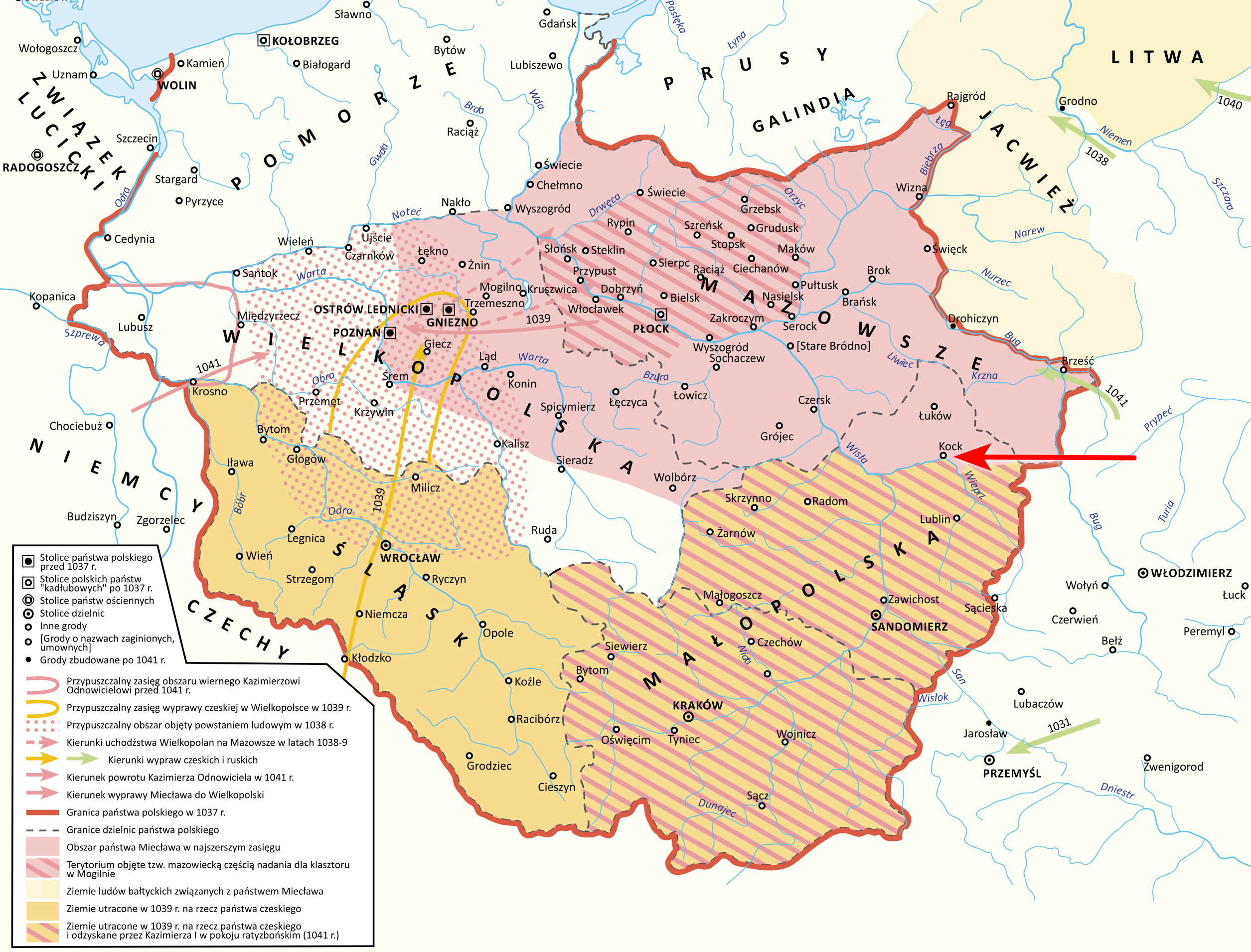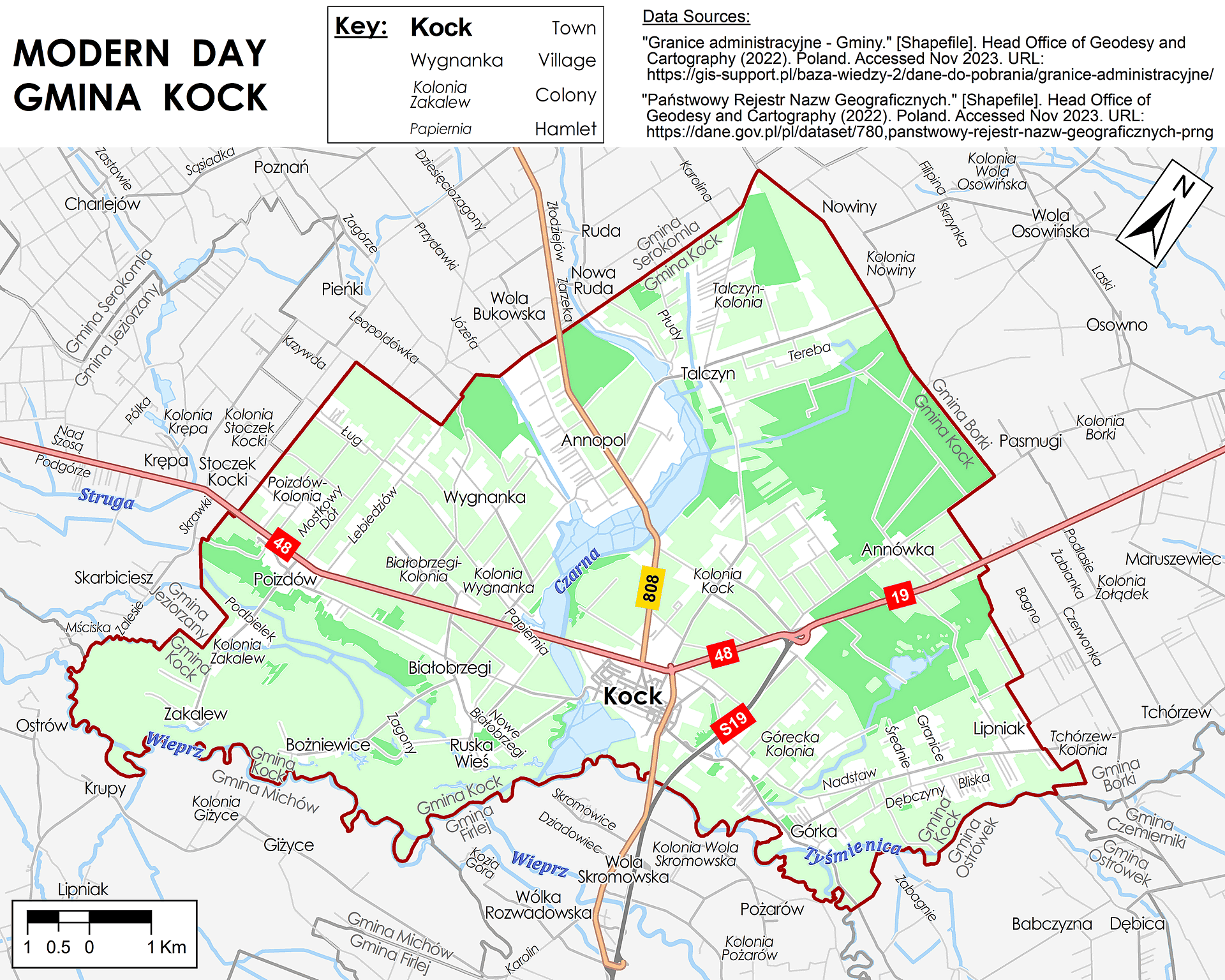HISTORY OF THE TOWN

The town has been recognized as an established community of Poland
since at least the 12th
century, though the earliest evidence of
human occupation in Kock dates back to around 5000 BC, and was historically occupied by the Yotvingians.
In the
early 13th
Century, Kock was acquired by the Bishop of Płock
and in 1233 was incorporated into the castellany of Łukow. The City Charter was granted to Kock by King Władysław II Jagiełło in
1417 upon request of the Bishop of Płock (Jakub of Korzkiew, c.
1350-1425). In 1512, Kock became a royal city for a short period before becoming a private town owned by Mikołaj Firlej.
Early records identify the town as Cocsk
, and by the 15th
century, the spellings Kocsko
or Koczsko
are used.
By the 18th
century, the spelling of Kocko
is used, and shortly thereafter, the modern-day spelling of Kock
appears in archival records.
The Kock estate has historically consisted
of the town of Kock with the villages of Górka Kocka,
Pożarow, Sułoszyn, Łukowiec, Rozwadówek, Wola Skromowska, Skromowice, Białobrzegi,
Bożniewice, Zakalew, Skarbimierz, Poizdów,
Stoczek, Talczyn, and Tchórzew. The estate was previously part of the Łuków and then Stężyca castellanies.
In the 15th
century, the estates were the property of the Bishop of Płock.
In 1512, the Bishop Erasmus Ciołek traded the Kock estate to King
Sigismund I for the Raciąż estate, and Kock became the property of the
Polish-Lithuanian Commonwealth. King Sigismund, rewarding the merits of
Mikołaj Firlej, castellan of Krakow, hetman, gave him the Kock estate as
an interitance around 1518-1522, making it a private town.
After the Firlej family, the Kock estate was acquired by Stanisław Zbąski. Subsequently, the heir of these estates was Count Jan Wielopolski
of Pieskowa Skała, who married (as his third wife) Maria Anna d’Arquien, sister of the Queen Consort of Poland.

In the early 1700's, the Kock estates were acquired by Princess Karolina Theresa Radziwiłł, wife of Prince Kazimierz Leon Sapieha prior to his death in 1738, then wife of Józef Aleksander Jabłonowski until her death in 1765. The estates were gifted to Karolina's daughter from her first marriage, Princess Anna Paulina Sapieha, who married her stepfather's nephew, Jan Kajetan Jabłonowski in 1750.
Anna Jabłonowska is considered one of the most significant Polish women of the 18th
Century for the social reforms and scientific advocacy she undertook on her estates. She abolished socage and established a system of quit-rent in Kock and her other estates, and established hospitals in Kock and Siemiatycze around 1775.
Princess Anna Jabłonowska,
childless, bequeathed the Kock estate to her nephew, Prince Franciszek Sapieha, upon her death in early 1800.
Due to the innumerable debts that the estate was encumbered with,
he could not keep it, and one of the creditors, Jan Meyzner, a Warsaw banker,
purchased the estate around 1800. The same banker, having married one of his
three daughters to Baron d’Anstett, Minister and
Plenipotentiary of Russia at the Congress of Frankfurt, bequeathed the estate
to her as a dowry.
During the Partitions of Poland, Kock became part of West Galicia,
controlled by the Habsburg Empire, from around 1795 to 1809. In 1809,
thanks to Berek Joselewicz and his infantry, Kock was annexed to the
Duchy of Warsaw and subsequently became part of the Radzyń Powiat and Siedlce Department, part of the Podlasie Gubernia. After 1815, Kock was part of Congress Poland,
essentially a puppet state of the Russian monarchy.
In 1844, the Podlasie Gubernia was merged into the Lubelskie Gubernia, and Kock was again part of the Lubelskie Voivodeship until redivision of the Gubernia in 1867.

In 1862 the estate was inherited by Edward and Emilia Fenschaw,
nephews of the Minister d’Anstett. In 1869 they were sold to Count Adam Żółtowski (1814-1880) for rs. 251,119; his grandson, Józef Adam Karol Żółtowski (1875-1954), was the last owner of Kock before the outbreak of World War II.
During the period of ownership by the Żółtowski family, the estate of Kock consisted of the following villages and settlements: Białobrzegi, Wygnanka al. Regulacya, Talczyn, Annopol, Górka Kocka, Annówka, Lipniak, Nowa Rudka, Paprotnia, Kozisz,
and Leśniczówka. Gmina Kock contained the Kock estate, collectively known as the City (later Town) of Kock with the villages of
Białobrzegi, Bożniewice, Zakalew, Talczyn, Górka Kocka, Tchórzew, and Ruska
Wieś. In 1878, Tchórzew was separated from Gmina Kock.
Kock, which had been designated as a City as early as the 15th
Century, was lowered to the status of a Town in 1871, after members of the town participated in the January Uprising
. It remained as such until Poland regained independence after World War I.
Kock was later the site of the last battle between Poland and Nazi Germany as part of the Nazi's invasion of Poland. After learning that Warsaw had surrendered on September 28, 1939, General Franciszek Kleeberg, at the time situated with the SGO Polesie
near Włodawa, was determined to continue the defense. After reorganizing his troops, they moved towards the confluence of the rivers Tyśmienica and Wieprz, where they rejoined the cavalry of General Zygmunt Podhorski. The troops, comprised of about 18,000 men, moved into the forests around Kock and began to engage in guerilla warfare against Nazi forces.
While the Nazis knew that Polish troops remained in the region, they incorrectly assumed that the troops would be as demoralized as those encountered in Warsaw. As such, only a small force was initially sent to Kock on October 2, 1939, where fighting ensued that resulted in withdrawal of and large casualties to Nazi forces. For four days, Polish fighters successfully held back the Nazis and recaptured surrounding areas that had been captured or occupied by them. While the initial actions of Polish troops were successful, there were insufficient men and supplies on the Polish side to continue the defense as the Nazis continued to bring in reinforcements (for a total of about 30,000 Nazi men involved in the battle). Understanding this, and evidently placing a higher value on the lives of his men than Nazi Germany did on theirs, General Kleeberg made a decision to surrender to the Nazi forces. The surrender took place in front of the Jabłonowski Palace in Kock on October 6, 1939.
General Kleeberg was imprisoned in the Nazi's POW Camp Oflag IV-B Königstein, and died in the camp hospital in 1941. He was originally buried near the camp, but his body was resumed after the war and reburied in Kock with other fallen soldiers of the SGO Polesie. The highway that runs through the northwestern part of Kock was also named in his honor.